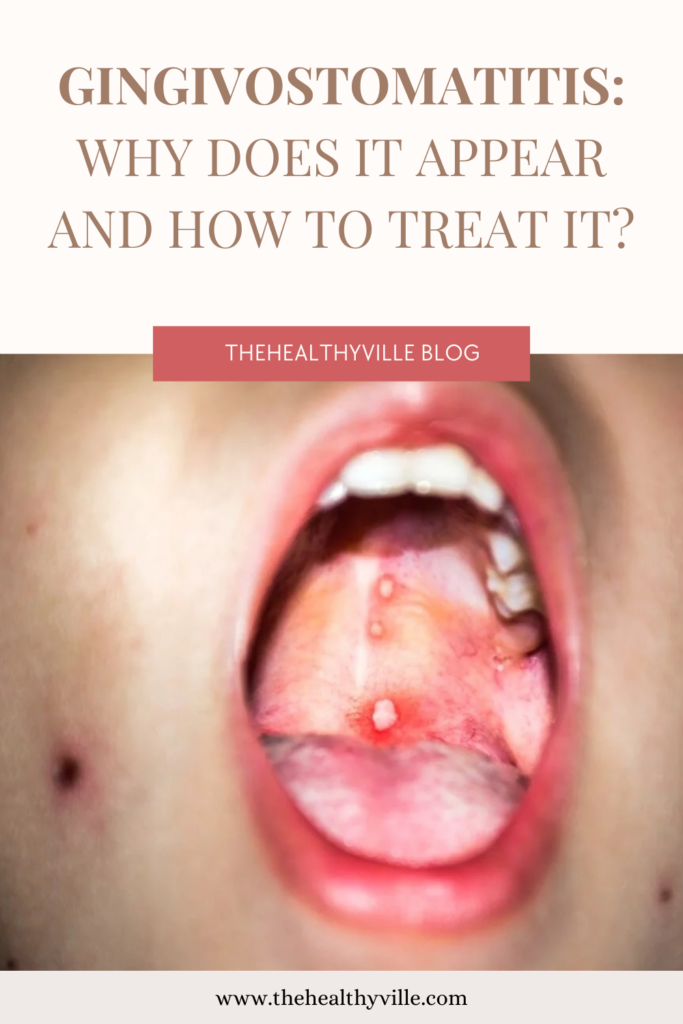Gingivostomatitis appears mostly in children, but you can prevent it and treat it if it happens. Learn all about it!
The appearance of many sores in the mouth of children may be due to gingivostomatitis. We tell you more about this annoying picture.
Lesions in the buccal mucosa can be due to different causes and affect both adults and children. In this article we tell you about gingivostomatitis in children; a disorder that causes a lot of discomfort in the mouth of the little ones.
It is a fairly common condition in childhood, as a result of a viral or bacterial infection. The most common is the one caused by the herpes simplex virus.
Oral lesions and discomfort characterize the condition that is often a cause for concern for parents. Well, in addition to the discomfort, the little ones drool excessively, have a fever and refuse to eat and drink.
What is gingivostomatitis?
Gingivostomatitis is a condition characterized by the appearance of multiple painful and annoying lesions on the oral mucosa. It most often occurs when herpes simplex virus type 1 (HSV-1) first infects the mouths of young children.
But this picture of inflamed mucous membranes and sores can also be caused by other infections. Coxsackie virus and Streptococcus and Actinomyces bacteria may be responsible, although less frequently.
Gingivostomatitis is a disease that occurs in infants and children, usually before the age of 6. The causative agent reaches the mouth through saliva.
And at a stage in which the child puts everything in his mouth; toys, glasses, pacifiers, bottles or any contaminated object can be the transmission route.
How it develops and manifests depends on many factors:
- Poor oral hygiene.
- Decreased defenses.
- Custom of kissing the child on the mouth.
- Nutritional deficiency, especially vitamins C and B.
- Habit of putting unwashed objects or hands into the mouth.
In the case of herpetic gingivostomatitis, once the condition is over, the virus usually remains stored in the child’s body and remains in a latent state. When situations arise that favor its reactivation, it can cause manifestations again, although milder than the first time.
Decreased defenses, stressful situations, exposure to the sun or cold, trauma and other states of immunosuppression predispose to reactivation of the virus. The lesions usually appear on the lips or inside the mouth and generate a characteristic itching sensation before becoming visible. They have the appearance of a cluster of small vesicles.
Symptoms
Gingivostomatitis in children manifests with inflammation and multiple painful ulcerations inside the mouth. They are located on the gums, cheeks, on the tongue, palate and the inner face of the lips. Although they can also affect the mucosa of the throat.
When the process begins, the lesions look like small red blisters with liquid content. When they break, they give rise to large ulcerations covered by a grayish or yellowish membrane and surrounded by an inflamed red halo.
These ulcers are very painful. It is what generates the discomfort and irritability of the child at all times.
In addition, patients with gingivostomatitis may present with the following associated symptoms:
- Bad breath.
- Headache.
- Excessive drooling.
- Tiredness and general malaise.
- Sore throat when swallowing.
- Persistent fever greater than 38 °C.
- Refusal to eat and drink.
- Cervical lymph nodes enlarged and painful.
- Red, inflamed, swollen gums that bleed easily.
How is it diagnosed?
In general, to arrive at the diagnosis of gingivostomatitis in children, the clinical examination of the mouth is usually sufficient. The characteristics of the lesions and the association of other symptoms guide the professional.
In any case, if the doctor thinks it is pertinent or considers that the process is not clear, some tests can be carried out. Taking a sample from the lesion and requesting a culture is a way to determine the agent that is causing the process. This way it will be possible to detect if it is a bacteria, such as strep throat, or something viral.
The doctor may also perform a biopsy, removing a piece of mucosa from the lesion. This is not the most common and is usually used in doubtful cases to rule out other types of mouth ulcers.
How to treat it?
The lesions and discomfort of gingivostomatitis in children usually last between 10 and 18 days. And in general they resolve without treatment, spontaneously.
But given the discomfort of the condition, the irritability of the child and the concern of the parents, the use of some therapeutic measures to calm the symptoms is necessary. Thus, medication and home remedies will be a relief that will help the little one to feel better until the process is complete.
To treat gingivostomatitis in children, it is essential to go to the pediatrician to evaluate the mouth and reach an accurate diagnosis. Well, many paintings may have similar symptoms, but will require other measures.
When the diagnosis is confirmed, the professional may prescribe pharmacological treatments for pain, fever and inflammation, such as ibuprofen. And if the process is caused by some bacteria, the use of an antibiotic may be necessary.
Remember that the child should never be medicated without the indication of a doctor.
The pediatrician may suggest using local anesthetics that are placed on the mucous membranes so that you do not feel pain at the time of eating. But its use is not so safe in children, so it is reserved for specific cases in which the professional considers it pertinent.
Finally, it is also essential to ensure that the child eats and hydrates properly while the infection is ongoing. Discomfort in the mouth often leads the child to reject food and thus increases the risk of dehydration.
How to care for the child at home?
Beyond the treatment suggested by the doctor, there are some home practices that can relieve discomfort. Here are tips that can help your little one feel better:
Take care of the diet: offering the child fresh and soft foods such as flans, gelatin, ice cream or applesauce helps reduce pain. Avoid giving your child hard, crispy, acidic, very salty or spicy foods.
- Hydration: giving plenty of water to drink avoids complications.
- Rest: it is important to help the child to rest. Naps will help you relax.
- Oral hygiene: the child should keep the mouth clean, brushing the teeth and tongue very gently.
- Avoid contagion: both the child and her caregivers must correctly and frequently wash their hands and the objects and utensils that the child puts in their mouth. If the infant attends a nursery, on those days she must rest.
Possible complications
Gingivostomatitis in children usually lasts about 2 weeks. After that time, the lesions disappear without leaving sequelae.
But you should know that, although it is not the most usual, there can be complications. One risk is dehydration. The refusal to eat and drink due to the discomfort of the sores in the mouth leads to the child not recovering the lost fluids.
When the process is due to the HSV-1 virus, there is the possibility of spreading it to other areas of the body. If the eyes become infected, for example, a condition called herpes keratitis develops.
Paronychia is the infection around the nails that also occurs due to accidental autoinoculation of the virus from mouth sores. Esophagitis, epiglottitis, encephalitis or pneumonitis are much rarer complications. They usually occur in children who suffer from a deficiency in their immune system.
When to go to the doctor?
When children have gingivostomatitis, parents should be aware of certain warning signs that may indicate that the process is not progressing well:
- Dizziness.
- Seizures.
- Dry mouth and skin.
- Absence of tears.
- Accelerated respiratory rate.
- Refusal to eat and drink liquids.
- Stomach pain, diarrhea, or rash.
- Tiredness, decay and excessive sleep.
- Very high and persistent fever that does not go down with medication.
- Persistence or worsening of sores after 2 weeks.
- Dry diapers, constipation, or a decrease in the number of daily urinations.
How to prevent it?
Taking care of children’s teeth and gums with proper oral hygiene helps reduce the risk of contracting this disease. Taking care of the diet and offering a varied and nutritious diet that guarantees the adequate supply of vitamins and minerals is also essential.
Avoiding physical contact with people who are experiencing an infection is also key to avoiding contagion. Likewise, it is important to insist on washing the hands of the patient and caregivers. As well as with the cleaning of toys, utensils and other objects that the little one puts in his mouth.
With good hygiene and eating habits, the risk of suffering from this type of disorder decreases. And at the same time, teach your children to be responsible with their health.
Don’t forget to SHARE all about gingivostomatitis with your friends and family on your social networks!

